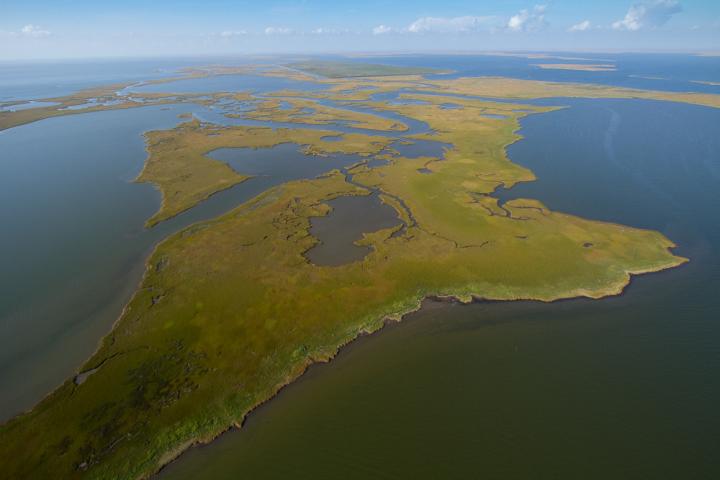
Today, a team of leading scientists and community experts with decades of experience released key recommendations to maintain and build land in coastal Louisiana. Their recommendations focus on operating Mississippi River sediment diversions and consider the needs of communities, wildlife and fisheries.
Seven LSU faculty served on the 12-member Sediment Diversion Operations Expert Working Group, which put forth these recommendations. LSU faculty lent their expertise in hydrology, oceanography, estuarine ecology, fisheries, wildlife, biogeochemistry, natural resource economics, law and policy.
"Over the past 50 years, Louisiana has lost 20 percent of its wetlands — an area the size of Delaware. People living near the coast depend on the wetlands for their livelihoods. This land loss also affects resident fish and animals, migrating birds and shrimp, crab and oysters that comprise valuable stock for the U.S. seafood industry," said John Andrew Nyman, LSU School of Renewable Natural Resources professor and one of the leading scientists in the working group. "Land loss over the next 50 years will be worse than it needs to be if we don't manage the river to build new wetlands."
The Sediment Diversion Operations Expert Working Group issued its recommendations after eight months of analysis and discussion, which included collaboration with more than 40 additional specialists on issues ranging from wetland health to socio-economic effects. In their report, the group recommends operating diversions to take full advantage of winter flood peaks and to target the rising flow of the spring flood peaks, establishing robust monitoring programs as well as flexibility to modify operations rapidly as conditions change and maintaining transparent and open communications with communities and industries that could be affected by diversions.
Sediment diversions are engineering structures consisting of gates and channels that will be built into Mississippi River levees to allow fresh river water, sediment and other nutrients to flow into wetlands to help build and sustain land. These manmade diversions will mimic the natural processes that originally built the land of coastal Louisiana. Lessons learned in Louisiana about how to use nature to rebuild land and protect coastal communities can be applied to other regions facing similar risks of coastal erosion, rising seas and increased storms.
The state of Louisiana is advancing two diversion projects south of New Orleans toward construction in 2020. Both the Mid Barataria and Mid Breton sediment diversions are included in the state's 2012 Coastal Master Plan, which was unanimously approved by the Louisiana Legislature. The Sediment Diversion Operations Expert Working Group, noting that how a sediment diversion is operated will be critical to its overall success, released their independent recommendations with the goal of informing the state as it starts to develop operations plans for these sediment diversions.
"These carefully researched recommendations provide an opportunity to maximize the tremendous land-building potential of sediment diversions, while seeking to protect Louisiana's abundant natural resources," said Natalie Peyronnin, director of science policy with the Environmental Defense Fund, who acted as facilitator for the working group.
Key recommendations include:
- Sediment diversions should be operated on a pulse that mimics the natural flood cycle of the Mississippi River, which includes taking full advantage of winter flood peaks from November through February when the greatest concentration of sediment is available in the river to sustain the coastal wetlands, as well as operating in the spring when sand needed for building land is at its highest.
- Operations plans should include robust monitoring and flexibility for adjustments based on rapidly changing conditions, such as hurricanes and other events.
- Diversions should be opened gradually over a 5-10 year period to help develop distributary channel networks, reduce flooding risks, and allow plants, fish, and wildlife species to adjust to new conditions.
- Local communities, industries and others that will be affected by diversions must be consulted and kept informed throughout all phases of diversion development and operations. Genuine attempts to mitigate socio-economic effects without compromising the effectiveness of the diversion are critical.
- A clear governance structure should be established to determine roles and responsibilities of all parties and to establish a transparent decision-making process for diversion operations.
Since the 1930s, Louisiana has lost nearly 1,900 square miles of land, or a football field of land every hour, primarily due to leveeing of the river for flood control and navigation. In the midst of this ongoing land loss crisis, sediment diversions are vital restoration tools needed to build and sustain coastal wetlands. These wetlands are crucial for protecting communities and industries from the effects of storms and rising seas as well as providing habitat for birds and wildlife.
###
Additional Link:
"Building Land in Coastal Louisiana: Expert Recommendations for Operating a Successful Sediment Diversion that Balances Ecosystem and Community Needs" report: http://www.mississippiriverdelta.org/files/2016/07/MRDRC_OWG_Main_Electronic.pdf
Media Contact
Alison Satake
[email protected]
225-578-3870
@LSUResearchNews
http://www.lsu.edu





